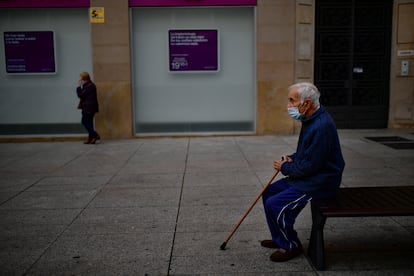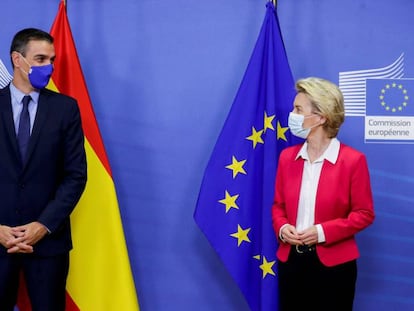Spain reports record 38,000 coronavirus cases in a single day, bringing total close to one million
The latest report from the Health Ministry included 217 new fatalities and indicated a rise in the hospital occupancy rate of Covid-19 patients


Spain is nearing the milestone of one million confirmed coronavirus infections, and on Monday registered a new record high number of cases reported in a single day. On Monday – no data is supplied over the weekend – the Health Ministry communicated 37,889 cases, the highest number seen in one of its daily reports. Before yesterday, the peaks in the data had been seen on the last two Mondays of September, with around 31,000 cases. Since the start of the pandemic, a total of 974,449 coronavirus cases have been detected in Spain.
The 14-day cumulative number of coronavirus cases per 100,000 inhabitants also came in at a record high on Monday, at 312. There are, however, large differences between the regions when it comes to this indicator. The regions that exceed the 500-case barrier are Navarre (945 cases), Melilla (713), La Rioja (531) and Aragón (509). This data point is one of the three criteria currently being used by the central government and the regions as triggers for stricter measures to be implemented, including perimetral confinements and social limits (the other two are the positivity rates of PCR tests and occupation levels of intensive care unit (ICU) beds). Only the Canary Islands, with 77 cases, is currently under the 100 level.
The health system continues to be under pressure and patient numbers are risingFernando Simón, director of the Health Ministry’s Coordination Center for Health Alerts
This record number of infections in a day is a “bad sign,” according to Ildefonso Hernández, the spokesperson for the Spanish Public Health Society (Sespas). But he qualified his view: “Let’s see what happens over the next few days. The European trend is going sharply upward and several of the large countries, such as the United Kingdom and France, are already surpassing us.” In Spain, he continued, the cases are rising, but “there are some regions that are low and are moving toward holding steady, while Madrid is also holding steady. What Catalonia does in the coming days, along with Madrid and Andalusia, will determine the general trend.” And he warned: “This virus is really difficult; there are still a lot of people who are susceptible and it will continue to spread.”
Pedro Gullón, a member of the Spanish Society of Epidemiology, pointed out that Spain has, for some time, had very high incidence and has been in a phase of rises and falls. The current wave, he added, appears to be “more consistent over time” and that “we will no doubt see more rises and falls with a lot of territorial differences.” He explained: “It appears that we reach a maximum but then cases do not fall; we go from a plateau with some rises and falls; now there is a rise.”
Fernando Simón, director of the Health Ministry’s Coordination Center for Health Alerts (CCAES), said on Monday night when he presented the latest data, that Spain is not progressing “as well as we would like.” Last week the government’s chief epidemiologist was talking about a stabilization of the pandemic in Spain. But yesterday he called the incidence “very high” and said that there is “a small rising trend,” similar to that being registered in the rest of Europe.

However, Simón underscored that the rise in cases in Spain has been slow and progressive, while the dynamic in other countries has been the multiplication of cases by a factor of two or three in a question of just two weeks. “I would like to think that we will go slower,” he said, taking for granted that infections will continue to grow. “It is to be expected that we will have a rise in incidence in the winter, if we don’t take into account the prevention measures.”
The daily report from the Health Ministry also added a further 217 victims to the official death toll, which now stands at 33,992. However, this does not include the thousands of fatalities during the first wave in spring, where no test had been carried out. According to the latest data from the National Statistics Institute (INE), the number of excess deaths in Spain since March is around 59,000 – i.e. there have been 59,000 more deaths this year than were expected compared to previous years. The number of Covid-19-related deaths according to Monday’s report detected over the last seven days is 459.
The occupation of ICU beds has also risen since the last report, which was released on Friday. One in every four ICU beds (21%) is now occupied by a coronavirus patient, again with major differences from region to region. In Ceuta, Melilla, Madrid, Aragón and La Rioja, the occupancy rate is around 40%. Castilla y León, meanwhile, comes in at 36%. In hospitals, one in every 10 ward beds (10.36%) is occupied by a Covid-19 patient across the country. Madrid and the North African city of Melilla exceed 20%. In total, there are 12,945 coronavirus patients receiving hospital treatment.
According to Monday’s report, 459 Covid-19 related deaths were detected over the last seven days
Fernando Simón also expressed concern about these hospital figures. While they have not risen rapidly, they mean “the health system continues to be under pressure and [patient numbers] are rising, with the problems that this can mean.” The CCAES director explained that the age range for which the biggest rise in incidence has been detected is 10 to 19, and he pointed to the high detection level of positive cases, with 40 to 45% of cases asymptomatic. The fatality rate continues to fall, he added, and is currently at 3.5%, compared to the 12.3% seen at the start of the pandemic.
“We are all very tired now,” said Simón, in reference to the restrictions that a number of regions have had in place for months. He also called for individual responsibility, and for citizens to comply with the rules “with even greater care” now that winter is approaching. This, he said, would “avoid other, more restrictive [measures] that would have a bigger social and economic impact.”
The cold weather, epidemiologist Pedro Gullón explained, “could see us take more activities indoors, where there is a greater risk, apart from also increasing the number of cases of similar seasonal diseases, such as the flu and other winter respiratory viruses, which could overwhelm the primary care system and laboratories even more because they share symptoms with Covid.”
As for the Madrid region, which had once again become the epicenter of the health crisis in Spain, Simón said that the progress is positive. The impact of the measures implemented in recent weeks – involving a perimetral confinement of nine municipalities, including the Spanish capital – had been “clearly beneficial,” he said. “We will have to see how things progress from here onward because this is not over,” he added. “Despite its progress being relatively good, Madrid still registered 439 cumulative cases per 100,000 inhabitants over 14 days, and that is a very high incidence,” he concluded.
Simón also explained on Monday that experts from the Madrid regional government and the Health Ministry are already working on a scenario once the state of alarm implemented by the central administration is lifted on Saturday, and for which there are no plans to extend. But, he added, “the politicians will have the last word.” There has been an ongoing battle in recent months between the government and the Madrid regional administration about how to tackle rising infection rates in the area, with the former calling for more widespread measures and the latter resisting for fears over the damage they would do to the economy. Simón pointed to the fact that the latest data showed that of the nine municipalities that have had perimetral lockdowns, seven are now “clearly below 500” cases per 100,000 inhabitants over 14 days, and “five of them are below 400.”
On Wednesday, regional chiefs will meet with the Health Ministry in order to study a new draft of an early response system that will be implemented when cases rise in an area of Spain, and will determine which measures should be taken according to a range of epidemiological criteria.
English version by Simon Hunter.
Tu suscripción se está usando en otro dispositivo
¿Quieres añadir otro usuario a tu suscripción?
Si continúas leyendo en este dispositivo, no se podrá leer en el otro.
FlechaTu suscripción se está usando en otro dispositivo y solo puedes acceder a EL PAÍS desde un dispositivo a la vez.
Si quieres compartir tu cuenta, cambia tu suscripción a la modalidad Premium, así podrás añadir otro usuario. Cada uno accederá con su propia cuenta de email, lo que os permitirá personalizar vuestra experiencia en EL PAÍS.
¿Tienes una suscripción de empresa? Accede aquí para contratar más cuentas.
En el caso de no saber quién está usando tu cuenta, te recomendamos cambiar tu contraseña aquí.
Si decides continuar compartiendo tu cuenta, este mensaje se mostrará en tu dispositivo y en el de la otra persona que está usando tu cuenta de forma indefinida, afectando a tu experiencia de lectura. Puedes consultar aquí los términos y condiciones de la suscripción digital.
More information
Últimas noticias
Most viewed
- Reinhard Genzel, Nobel laureate in physics: ‘One-minute videos will never give you the truth’
- Oona Chaplin: ‘I told James Cameron that I was living in a treehouse and starting a permaculture project with a friend’
- Pablo Escobar’s hippos: A serious environmental problem, 40 years on
- Charles Dubouloz, mountaineering star, retires at 36 with a farewell tour inspired by Walter Bonatti
- Why we lost the habit of sleeping in two segments and how that changed our sense of time









































